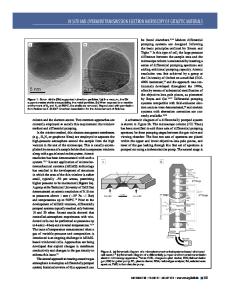Transmission Electron Microscopy Study of Cascade Collapse in Copper During in- Situ Ion- Irradiation at Elevated Temper
- PDF / 1,427,119 Bytes
- 6 Pages / 414.72 x 648 pts Page_size
- 105 Downloads / 295 Views
fully addressed. During ion-irradiation an increase in 1.2 defect loss rate over those rates measured 1.0 • S1.0 under similar conditions without ion0 0.8 irradiation has been observed [2, 3]; this .0.8 0.6 n" increase was reported to scale with ion0.6 0.6 CL fluence. The immediate question arises as to 0.4 whether a temperature dependence for the S0.4 z isothermal loss rate during ion-irradiation 0.2 . . 0.2 can account for the change in post100 keV Kr lon-Irradiation of Cu ;n n irradiation yield. In our previous work [1], 500 600 0 100 200 300 400 only limited data addressing this concern Temperature (°C) was available to support a temperature Figure 1: Post-irradiation defect yields measured from dependence for the yield. extrapolations of isothermal anneal data for 100 keV Kr ionTo adequately resolve this point, it is irradiations of fcc-Cu. The bar represents the weighted average for measurements near 23°C. The curve through the necessary to directly observe the production data displays a trend and is not fitted to a model. and loss of defects during ion-irradiation at elevated temperature. This can be accomplished through the analysis of video recorded TEM images. In this paper we discuss some of the preliminary results from our in-situ TEM observations of defect formation and loss during ion-irradiation at elevated temperatures. Post-Irradiation Defect Yield
EXPERIMENT TEM samples were prepared from a rolled polycrystalline copper sheet of 99.99% nominal purity and a single crystal copper rod of 99.999% nominal purity cut into 3 mm diameter disks. The single crystal was sliced with the [100] zone axis near normal to the plane of the disk. The copper disks were sealed in quartz tubes, evacuated to 2x10-6 torr, then backfilled with high purity argon, and annealed for 2 hours (polycrystalline) or 4 hours (single crystal) at 1093°K (0.8 Tmelt). Annealed disks were electro-polished to perforation using an electrolytic solution of 500 ml methanol, 30 ml nitric acid, and 5 ml 2-butylethanol at 238°K and stored under 10-8 torr prior to insertion into the TEM for examination. The microscopy was performed in the HVEM-Tandem facility at Argonne National Laboratory using a Hitachi H-9000NAR TEM interfaced with a 2 MV tandem ion accelerator and a 0.65 MV ion implanter. The ion implanter was used to produce 100 keV Kr ion beams with typical fluences between (9.4 < D < 14.1) x10 10 ions-cm- 2 . In-situ ion-irradiations were conducted in the TEM with the ion-beam at near normal incidence to the foil surface. Further details describing the H-9000NAR TEM / accelerator arrangement are given by Allen [4]. The microscope was equipped with a Gatan model 622SC image intensified video rate camera which was connected to a VCR, enabling the in situ recording of images during ion-irradiations. A Gatan model 652 double-tilt, side-entry, elevated temperature goniometer stage was used. The microscope was operated at low-voltage (100 keV) to reduce the influence of electron irradiation on the production and subsequent evolution of defects
Data Loading...











